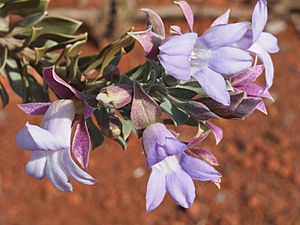Spoon-leaved eremophila facts for kids
Quick facts for kids Spoon-leaved eremophila |
|
|---|---|
 |
|
| Eremophila spathulata leaves and flowers | |
| Scientific classification | |
| Genus: |
Eremophila (plant)
|
| Species: |
spathulata
|
Eremophila spathulata, often called the spoon-leaved eremophila, is a beautiful flowering plant. It belongs to the figwort family, known as Scrophulariaceae. This plant is special because it only grows naturally in Western Australia. It is a shrub with many tangled branches. Its leaves are stiff, grey, and shaped like spoons. The flowers have reddish-purple parts called sepals and blue, pink, or violet petals.
Contents
What Does the Spoon-leaved Eremophila Look Like?
The spoon-leaved eremophila is a shrub with many tangled branches. It usually grows to be about 0.6 to 1.0 meter (2 to 3 feet) tall. Its branches and leaves are covered with soft, silvery-grey hairs. These hairs lie flat against the plant's surface.
The leaves are thick and stiff. They can be egg-shaped, spoon-shaped, or lance-shaped. Most leaves are about 17 to 30 millimeters (0.7 to 1.2 inches) long. They are also about 6 to 14 millimeters (0.2 to 0.6 inches) wide.
Flowers and Fruits
The flowers usually grow one by one where the leaves meet the stem. They sit on stalks that are about 7.5 to 13 millimeters (0.3 to 0.5 inches) long. These stalks have the same hairy covering as the leaves.
Each flower has five overlapping, hairy parts called sepals. These sepals are reddish-purple to purple and are about 9 to 17 millimeters (0.4 to 0.7 inches) long. The petals are about 25 millimeters (1 inch) long. They join together at their bottom to form a tube.
The petal tube and its tips can be blue, pink, or violet. The outside of the petal tube is hairy. The inside of the tips is smooth, but the inside of the tube is full of soft, woolly hairs. There are four stamens (the parts that make pollen) hidden inside the petal tube.
This plant flowers between July and October. After flowering, it produces fruits. These fruits are dry, woody, and oval-shaped. They are about 5.5 to 9 millimeters (0.2 to 0.4 inches) long. Each fruit has a hairy, papery covering.

How the Spoon-leaved Eremophila Got Its Name
The plant Eremophila spathulata was first officially described in 1904. This was done by a person named William Vincent Fitzgerald. He published his description in a scientific journal.
The second part of its name, spathulata, comes from a Latin word. It means 'spatula-shaped'. This name was chosen because of the unique spoon-like shape of its leaves.
Where Does the Spoon-leaved Eremophila Grow?
The spoon-leaved eremophila grows in sandy soil or loam. You can find it on stony flats and ridges. It grows in a specific area of Western Australia. This area is between the towns of Meekatharra and Byro Station. These regions are known as the Gascoyne and Murchison areas.
Is the Spoon-leaved Eremophila Endangered?
The Western Australian Government's Department of Parks and Wildlife checks on plants like this. They have classified Eremophila spathulata as "not threatened." This means it is not currently at risk of disappearing.
Growing This Plant
This eremophila is a slow-growing shrub. But when it grows up, it puts on a beautiful show of flowers. It has colorful sepals and blue or violet petals.
It can be a bit tricky to grow new plants from cuttings (small pieces of the plant). It is more often grown by grafting. This means joining a piece of the spoon-leaved eremophila onto the root system of another plant, like a Myoporum.
This plant likes soil that drains water well. It can grow in full sun or in a bit of shade. It is also good at handling dry weather. It only needs water sometimes during long dry periods. It can also handle light frosts.

